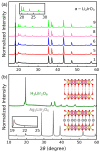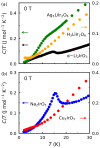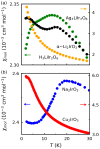Metastable Kitaev Magnets
- PMID: 35164130
- PMCID: PMC8840360
- DOI: 10.3390/molecules27030871
Metastable Kitaev Magnets
Abstract
Nearly two decades ago, Alexei Kitaev proposed a model for spin-1/2 particles with bond-directional interactions on a two-dimensional honeycomb lattice which had the potential to host a quantum spin-liquid ground state. This work initiated numerous investigations to design and synthesize materials that would physically realize the Kitaev Hamiltonian. The first generation of such materials, such as Na2IrO3, α-Li2IrO3, and α-RuCl3, revealed the presence of non-Kitaev interactions such as the Heisenberg and off-diagonal exchange. Both physical pressure and chemical doping were used to tune the relative strength of the Kitaev and competing interactions; however, little progress was made towards achieving a purely Kitaev system. Here, we review the recent breakthrough in modifying Kitaev magnets via topochemical methods that has led to the second generation of Kitaev materials. We show how structural modifications due to the topotactic exchange reactions can alter the magnetic interactions in favor of a quantum spin-liquid phase.
Keywords: magnetism; metastable; topochemical.
Conflict of interest statement
The authors declare no conflict of interest.
Figures







References
-
- Takagi H., Takayama T., Jackeli G., Khaliullin G., Nagler S.E. Concept and realization of Kitaev quantum spin liquids. Nat. Rev. Phys. 2019;1:264–280. doi: 10.1038/s42254-019-0038-2. - DOI
-
- Plumb K.W., Clancy J.P., Sandilands L.J., Shankar V.V., Hu Y.F., Burch K.S., Kee H.Y., Kim Y.J. α-RuCl3: A spin-orbit assisted Mott insulator on a honeycomb lattice. Phys. Rev. B. 2014;90:041112. doi: 10.1103/PhysRevB.90.041112. - DOI
-
- Williams S.C., Johnson R.D., Freund F., Choi S., Jesche A., Kimchi I., Manni S., Bombardi A., Manuel P., Gegenwart P., et al. Incommensurate counterrotating magnetic order stabilized by Kitaev interactions in the layered honeycomb α-Li2IrO3. Phys. Rev. B. 2016;93:195158. doi: 10.1103/PhysRevB.93.195158. - DOI
Grants and funding
LinkOut - more resources
Full Text Sources

